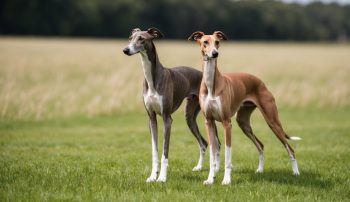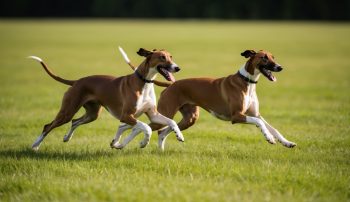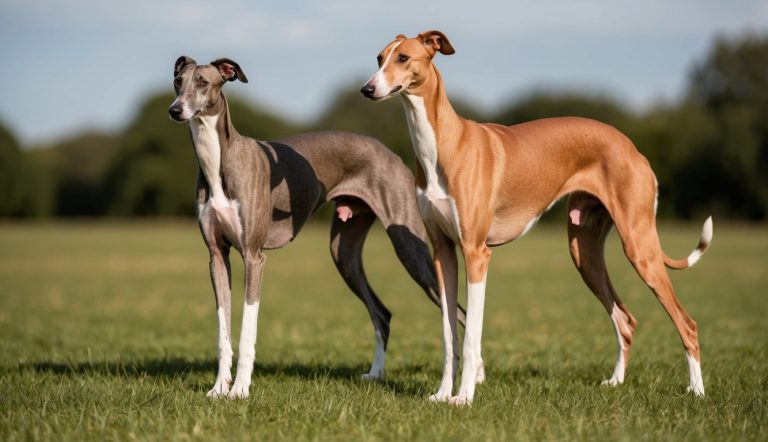Comparing Greyhounds and Whippets

Greyhounds and Whippets share many similarities as sighthounds, but they have distinct differences in size, temperament, and care needs. Understanding these differences can help you choose the right breed for your lifestyle.
Physical Characteristics
- Full-grown Greyhounds weigh 60-100 pounds, while Whippets reach 25-40 pounds at maturity.
- Greyhounds stand 28-30 inches tall, compared to Whippets at 18-22 inches.
- Greyhounds have longer muzzles and legs proportional to their larger size. Whippets look like smaller versions of Greyhounds, with more compact frames.
- Both breeds have sleek, muscular bodies built for speed.
- They share similar coat types – short, smooth, and low-shedding.
- Color variations are wide for both breeds, including solid colors, brindles, and various patterns.
Temperament and Behavior
- Greyhounds and Whippets are gentle, affectionate dogs that bond closely with their families.
- Both breeds can get along well with other pets when properly socialized.
- Whippets tend to be more energetic and playful than Greyhounds.
- Both breeds enjoy short bursts of exercise but are content to lounge for much of the day.
Trainability and Intelligence
- Greyhounds and Whippets are intelligent breeds that respond well to positive reinforcement training methods.
- Both breeds are eager to please their owners.
- Whippets may be slightly more adaptable in training, whereas Greyhounds can sometimes be more independent or stubborn.
- Short, engaging training sessions work best for both breeds.
Health and Longevity

Both Greyhounds and Whippets are generally healthy breeds. Their common health issues and longevity differ slightly. Let’s look at the specific health considerations for each breed.
Common Health Issues
- Greyhounds can be prone to certain health problems like bloat, osteosarcoma, and dental issues.
- Whippets tend to be quite healthy overall, but watch out for eye problems and heart murmurs.
Exercise and Energy Levels
Greyhounds and Whippets have different exercise needs. Their energy levels and activity requirements vary, which can impact your choice between these sighthound breeds.
Greyhound Activity Needs
Greyhounds are often called “40 mph couch potatoes.” They need short bursts of intense exercise followed by long periods of rest. These dogs also enjoy sprinting in enclosed areas, so you should give them a chance to run freely in a fenced yard or dog park a few times a week.
Whippet Exercise Requirements
Whippets have medium to high energy levels. Plan for 30-60 minutes of activity daily, split into two sessions if possible. Like Greyhounds, Whippets love to run, too. They benefit from off-leash sprinting in secure areas. A fenced backyard is ideal for a Whippet to burn off energy.
Living with a Sighthound

Sighthounds make unique pets. Their athletic build and gentle nature require specific care and attention.
Housing and Space Considerations
Sighthounds need room to stretch out. A large dog bed is essential for their comfort. While Whippets can adapt to smaller homes, Greyhounds prefer more space. Furthermore, Sighthounds have thin coats and little body fat, so keep your home warm in winter. Provide cozy blankets and sweaters for outdoor activities.
Compatibility with Children and Pets
Sighthounds are typically gentle with kids. Supervise interactions, especially with young children. You should also teach kids to respect the dog’s space. These breeds also often get along with other dogs. Just make sure to Introduce new pets slowly.
Grooming and Maintenance
Greyhounds and Whippets have different coat types that affect their grooming needs. Both breeds require regular care to keep them looking their best.
Greyhound Grooming Routines
- You’ll need to brush your Greyhound once a week with a soft bristle brush or grooming mitt.
- Bathe your dog every 2-3 months or when they get dirty.
- Greyhounds need regular nail trims every 2-3 weeks.
- Check and clean your dog’s ears weekly.
Whippet Coat and Care
- Whippets have a fine, short coat that’s simple to groom.
- Bathe your dog every 2-3 months or as needed.
- Whippets need their nails trimmed every 2-3 weeks.
- Check your dog’s ears weekly for dirt or signs of infection.
Nutrition and Diet
Proper nutrition is key for both Greyhounds and Whippets. These sighthounds have specific dietary needs to maintain their lean bodies and high energy levels.
Feeding a Greyhound
- Greyhounds need a diet high in protein and fat.
- Look for foods with meat as the first ingredient.
- Avoid foods with fillers like corn or wheat.
- Watch your dog’s weight closely because They should have a visible waistline and you should be able to feel their ribs.
Optimal Diet for Whippets
- Feed your Whippet 2-3 times daily and usually 1-2 cups of high-quality dog food per day.
- Choose foods high in protein with healthy fats.
- Monitor your Whippet’s weight carefully, as they should have a defined waist and visible ribs.
- Consider adding fish oil to your Whippet’s diet for coat health.
Training and Socialization

Both Greyhounds and Whippets need consistent training and early socialization. These sighthounds respond well to positive reinforcement methods. Proper training helps them become well-behaved companions.
Basic Training Techniques
- Start training your Greyhound or Whippet as early as possible.
- Use short sessions to keep their attention.
- Reward good behavior with treats and praise.
- Focus on essential commands like sit, stay, and come.
- Practice leash training to control their strong prey drive.
- Be patient and consistent.
Socializing Your Sighthound
- Expose your Greyhound or Whippet to different people, animals, and environments from a young age.
- Take them to dog parks or puppy classes so they can interact with other dogs under supervision.
- Introduce them to various sounds, sights, and textures.
- Remember that both breeds can be shy around strangers so encourage positive interactions with new people.




